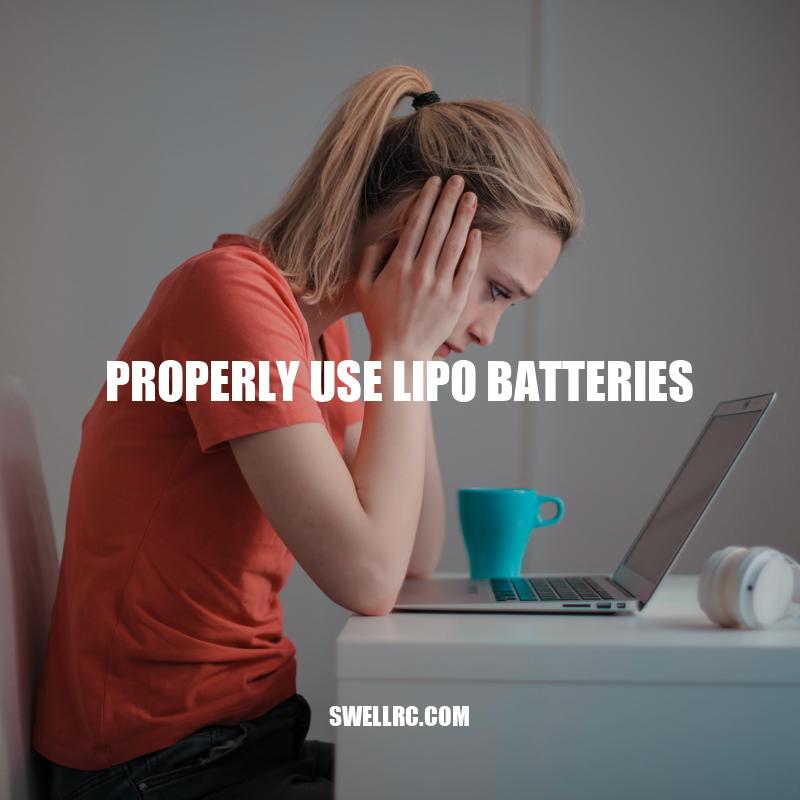Properly Using Lipo Batteries: Essential Safety Tips
Lipo batteries are a popular source of power for many electronic devices due to their high energy density, low weight, and small size. They are commonly used in devices such as drones, RC cars, and power banks. However, lipo batteries can be dangerous if not handled properly, as they are prone to fires and explosions if not used and maintained correctly. Mishandling a lipo battery can cause damage to property, injury, and even death. Therefore, it’s essential to learn about the proper use and care of lipo batteries to ensure that they operate safely and efficiently. This article will provide you with the knowledge and safety tips necessary to help you properly use lipo batteries, ensuring that you minimize the risk of injury and damage while efficiently powering your devices. From purchasing a high-quality lipo battery to storing and transporting it correctly, these tips will help you get the most out of your lipo battery while ensuring safe operation.
How to purchase a high-quality lipo battery
There are several important factors to consider when purchasing a high-quality lipo battery, including:
- Brand reputation: Choose a renowned brand that has a track record of producing high-quality batteries.
- Capacity and discharge rate: Check the specifications of the lipo battery to ensure that its capacity and discharge rate are suitable for your device’s power needs.
- Voltage: Ensure that the voltage of the lipo battery matches the device’s voltage requirements.
- Age of the battery: Always purchase a new battery to ensure its efficiency and health.
It’s recommended to purchase lipo batteries from reputable vendors such as hobby shops, specialized online stores, or manufacturer websites. Be cautious of low-priced batteries or no-name brands, as they may be less reliable and dangerous to use. Always follow the recommended usage guidelines provided by the manufacturer to get the most out of your lipo battery while ensuring safe operation.
How do I choose a good LiPo battery?
When choosing a LiPo battery, here are a few factors to consider:
- Voltage: Look for a battery with a voltage that matches your device’s requirements.
- Capacity: The capacity of a battery is measured in milliampere-hours (mAh), which is an indication of how long the battery will last. Choose a battery with a capacity that will meet your needs.
- C-rating: The C-rating indicates the discharge rate of the battery. Choose a battery with a C-rating that matches your device’s requirements.
- Brand reputation: Choose a battery from a reputable brand to ensure quality and safety.
Some recommended websites for purchasing LiPo batteries include HobbyKing, Giant Power, and Venom Power. Be sure to read reviews and do your research before making a purchase.
How to Check Lipo Battery Voltage and Capacity
To ensure that your lipo battery is fully charged and healthy, you can check its voltage and capacity regularly. Here’s how to do it:
| Tool | Process |
|---|---|
| Multimeter | Set the multimeter to read DC voltage, touch the probes to the battery’s positive and negative terminals, and read the voltage on the display. A healthy lipo battery should have a voltage within the manufacturer’s recommended range. |
| Battery checker | Connect the battery checker to your battery and read the capacity and voltage information on the display. A healthy lipo battery should have a capacity close to its rated capacity and a voltage within the recommended range. |
Interesting fact: Lipo batteries have a higher energy density than other battery types and hence can provide more power in a smaller and lighter package than other types of batteries.
You can purchase a reliable lipo battery and multimeter on Amazon or at your local hobby store. Don’t forget to regularly check the voltage and capacity of your lipo batteries to prevent damage and ensure optimal performance.
How do I check my LiPo battery capacity?
To check the capacity of your LiPo battery, you can use a battery checker or a multimeter. Here are the steps to follow:
- Turn off your LiPo battery and unplug it from your device.
- Connect the battery checker or multimeter to the battery.
- Turn on the battery checker or multimeter.
- The capacity of the LiPo battery should be displayed.
It’s important to regularly check the capacity of your LiPo battery to ensure it is functioning properly and to prevent any potential issues. There are many battery checkers and multimeters available online, such as the Tenergy TB6-B Balance Charger Discharger or the Floureon Digital Multimeter.
Sure, here’s the revised paragraph with bolded keywords and phrases using HTML formatting:
To prevent accidents and damage, it’s crucial to store and transport lipo batteries safely. Here are some tips:
- Use a lipo battery bag or a fireproof container to store your batteries when not in use.
- Keep your batteries away from water, heat sources, and sharp objects that can damage them.
- Store your batteries in a dry and cool place, away from direct sunlight and extreme temperatures.
- Don’t leave your batteries inside a parked car or other hot or cold environments for extended periods.
- Transport your batteries in a lipo bag or a fireproof container that’s specifically designed for battery transportation.
- Label your battery bag/container with a warning label that indicates the type and number of batteries inside.
It’s essential to follow the safety guidelines while handling lipo batteries to avoid hazardous incidents. Check out safety guides on the battery manufacturer’s website to learn more about the safe use of lipo batteries.
How do you store LiPo batteries safely?
To store LiPo batteries safely, follow these tips:
– Store batteries at room temperature (around 68°F/20°C)
– Store batteries in a fireproof container or lipo bag
– Store batteries at a partial charge (around 50% of maximum charge)
– Keep batteries away from flammable materials and liquids
– Store batteries in a dry and cool place
For more information on LiPo battery safety, visit the website of manufacturers like Tattu or Venom. They offer comprehensive guidelines and products like fireproof storage bags to ensure the safe storage of LiPo batteries.
Using a lipo battery charger safely
A lipo battery charger should be handled with caution to prevent battery damage or hazardous incidents. Here are some tips to use a lipo battery charger safely:
- Use a lipo battery charger that’s compatible with your battery type, voltage, and capacity.
- Don’t use a charger that’s designed for a different battery type or voltage, as it can damage the battery or cause fires or explosions.
- Ensure that the charger’s voltage and current are set correctly before charging. Incorrect settings can cause battery damage, overheating, and hazardous incidents.
- Place your battery in the charging bag or container before starting the charging process.
- Never leave your battery unattended while charging.
- Stop the charging process if you notice any signs of overheating, such as smoke or a hot battery.
- Let your battery cool down before charging it again. Charging a hot battery can cause damage and hazardous incidents.
Make sure to follow the manufacturer’s instructions while charging your lipo battery to prevent accidents or damage. Also, consider purchasing a lipo battery charger that has safety features such as overcharge protection, charge rate control, and automatic cut-off to ensure the safe charging of your lipo batteries.
What are the safety precautions for battery charger?
- Always follow the manufacturer’s instructions for using the battery charger.
- Make sure to use the right charger for your battery.
- Keep the charger away from flammable materials.
- Make sure to charge the battery in a well-ventilated area.
- Do not leave the battery charger unattended while it is in use.
- Unplug the charger when it is not in use.
It’s important to prioritize safety when using a battery charger. Be sure to read the instructions and follow all safety guidelines. For more information on battery chargers, check out reputable websites such as Battery University or BatteryStuff.com.
Common Mistakes in Using Lipo Batteries
Even with proper handling and care, it’s easy to make mistakes when using lipo batteries. Here are some common mistakes to avoid:
- Using a damaged or punctured battery: A damaged battery can cause fires and explosions, so it’s crucial to check for any signs of damage before using or charging it.
- Disregarding the voltage and capacity of the battery: Using a charger or device that’s not compatible with your battery’s voltage and capacity can damage the battery and lead to hazardous incidents.
- Charging your battery too fast: Overcharging your battery or charging it too fast can cause damage, overheating, and explosions.
- Over-draining your battery: Over-discharging or leaving your battery unused for too long can cause it to lose its capacity and reliability.
- Storing your battery in a hot environment: A hot environment can cause your battery to overheat and lose its capacity.
- Ignoring the manufacturer’s instructions: Each battery and device has different specifications and requirements, so it’s essential to read the manufacturer’s instructions and follow them carefully.
Taking necessary precautions and avoiding these common mistakes can ensure the safe and efficient use of your lipo batteries. If you’re unsure about any aspect of handling, charging, or storing your lipo batteries, seek advice from a professional or the battery manufacturer’s website.
What is the biggest hazard of LiPo batteries?
The biggest hazard of LiPo batteries is the risk of fire or explosion. This can occur when the battery is overcharged, damaged, punctured or short-circuited. LiPo batteries contain a flammable electrolyte that can ignite when exposed to air. It is important to follow safe charging and handling practices, such as using a LiPo-safe charging bag and avoiding physical damage to the battery.
For more information about LiPo battery safety, visit the websites of reputable manufacturers such as Turnigy or Venom.
Conclusion
Lipo batteries are powerful energy sources that can provide long-lasting power but require proper handling and care to prevent hazardous incidents. Using high-quality lipo batteries, checking the voltage and capacity, storing, and transporting them safely, avoiding common mistakes, and following the manufacturer’s instructions can ensure their efficient and safe use.
Remember that lipo batteries can pose a severe risk if misused, so it’s essential to follow the safety tips mentioned in this article. By doing so, you’ll not only protect yourself and your devices but also extend the life of your lipo batteries.
Ultimately, lipo batteries offer a convenient and reliable power source, but their safe use requires personal responsibility and attention to detail. Being aware of the potential hazards and taking necessary precautions can make a significant difference in using these batteries safely and efficiently.



